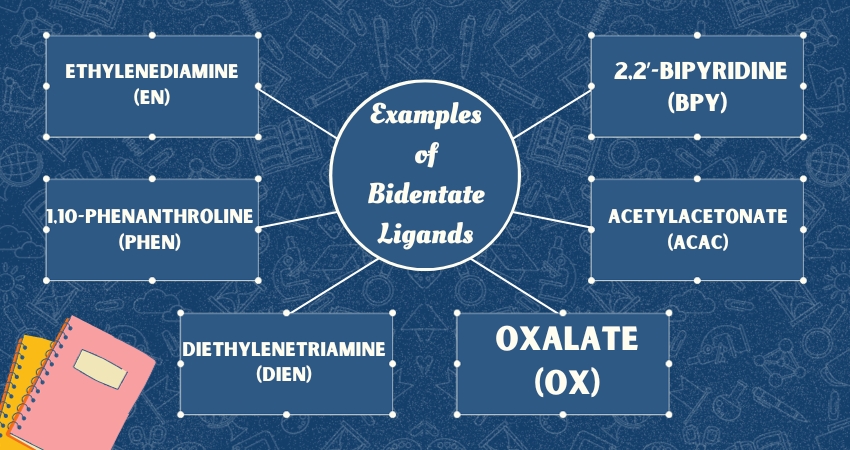Bidentate ligands play a crucial role in coordination chemistry. They serve as molecules or ions with two donor atoms capable of binding to a central metal atom or ion at two distinct points. This blog will explore the diversity of bidentate ligands, shedding light on their structures, properties, and significance in various fields. To begin, let’s define bidentate ligands and delve into the concept of chelation and the chelate effect.
Definition of Bidentate Ligands
Bidentate ligands are molecules or ions featuring two donor atoms that can bind to a central metal atom or ion at two distinct points. This unique characteristic imparts enhanced stability and affinity to metal complexes, a phenomenon known as the chelate effect.
Chelation and the Chelate Effect: Chelation occurs when a single ligand forms multiple bonds with a metal ion. The resulting complexes, known as chelates, exhibit increased stability compared to their monodentate counterparts. The chelate effect arises from the cooperative binding of bidentate or multidentate ligands.
Examples of Bidentate Ligands
The examples of bidentate ligands are deeply discussed in given below;
1. Ethylenediamine (en)
- Formula: C2H4(NH2)2
- Description: Symmetrical molecule with two amino groups.
2. 2,2’-Bipyridine (bpy)
- Formula: C10H8N2
- Description: Consists of two pyridine rings linked at the 2nd position.
3. 1,10-Phenanthroline (phen)
- Formula: C12H8N2
- Description: Planar, aromatic ligand with two nitrogen atoms.
4. Diethylenetriamine (dien)
- Formula: C4H13N3
- Description: Features three amino groups separated by ethylene linkers.
5. Oxalate (ox)
- Formula: C2O42−
- Description: Dianion with two carboxylate groups.
6. Acetylacetonate (acac)
- Formula: C5H7O2−
- Description: Consists of a β-diketone structure.
7. Malonate (mal)
- Formula: C3H2O42−
- Description: Dianion with two carboxylate groups separated by a methylene bridge.
8. Salicylate (sal)
- Formula: C7H5O3−
- Description: Derivative of salicylic acid with a carboxylate group.
9. Ethoxide (EtO)
- Formula: C2H5O−
- Description: Ethyl group attached to an oxygen atom.
10. Methoxide (MeO)
- Formula: CH3O−
- Description: Methyl group attached to an oxygen atom.
Also Read: 20 Examples of Polydentate Ligands
The Importance of Bidentate Ligands in Coordination Chemistry
Bidentate ligands, molecules or ions with two donor atoms capable of binding to a central metal atom or ion at two distinct points, play a pivotal role in coordination chemistry. Their importance stems from various characteristics and applications, making them key players in the formation and stability of metal complexes. Here are some crucial aspects highlighting the significance of bidentate ligands:
- Enhanced Stability: Bidentate ligands contribute to the enhanced stability of metal complexes through chelation, a process where a ligand forms multiple bonds with a metal ion. The resulting chelates are often more stable than their monodentate counterparts, a phenomenon known as the chelate effect. This increased stability has profound implications in the design and synthesis of coordination compounds.
- Selective Metal Binding: The ability of bidentate ligands to bind to metal ions at two distinct points provides a level of selectivity in metal coordination. This selectivity is crucial in various applications, such as catalysis and bioinorganic chemistry, where specific interactions between ligands and metal ions are desired for optimal performance.
- Catalytic Activity: Bidentate ligands are commonly employed in catalysis, influencing reaction rates and selectivity. The chelating effect enhances the catalytic efficiency of metal complexes, making them valuable in industrial processes and laboratory-scale reactions. The controlled coordination environment provided by bidentate ligands contributes to the precision of catalytic systems.
- Biological and Medicinal Applications: In bioinorganic chemistry, bidentate ligands are prevalent in metalloenzymes and biomimetic catalysts. The structural and electronic properties of these ligands make them suitable for mimicking the active sites of biological systems. Additionally, metal complexes with bidentate ligands are explored for medicinal purposes, including drug delivery and imaging, owing to their controlled reactivity and potential therapeutic effects.
- Environmental Remediation: Bidentate ligands find applications in environmental remediation efforts. Metal complexes formed with these ligands can be utilized to remove or immobilize toxic metals from contaminated environments. The selective binding ability of bidentate ligands aids in the design of effective strategies for cleaning polluted water or soil.
- Structural Diversity: The diverse nature of bidentate ligands allows for the creation of a wide range of coordination geometries and structures. This structural diversity is valuable in tailoring the properties of metal complexes for specific purposes, ranging from magnetic materials to sensors and electronic devices.
- Versatility in Synthesis: Bidentate ligands are versatile in their synthesis and modification. This flexibility enables the fine-tuning of ligand properties, such as electronic and steric effects, to meet the requirements of a particular application. The ease of modification contributes to the adaptability of these ligands in various chemical contexts.
Bidentate ligands enhance stability, provide selectivity in metal binding, and contribute to catalysis, biological processes, medicinal applications, environmental remediation, and structural diversity in coordination chemistry. Their unique characteristics make them indispensable tools in designing and synthesizing metal complexes with tailored properties for a wide array of scientific and industrial applications.

